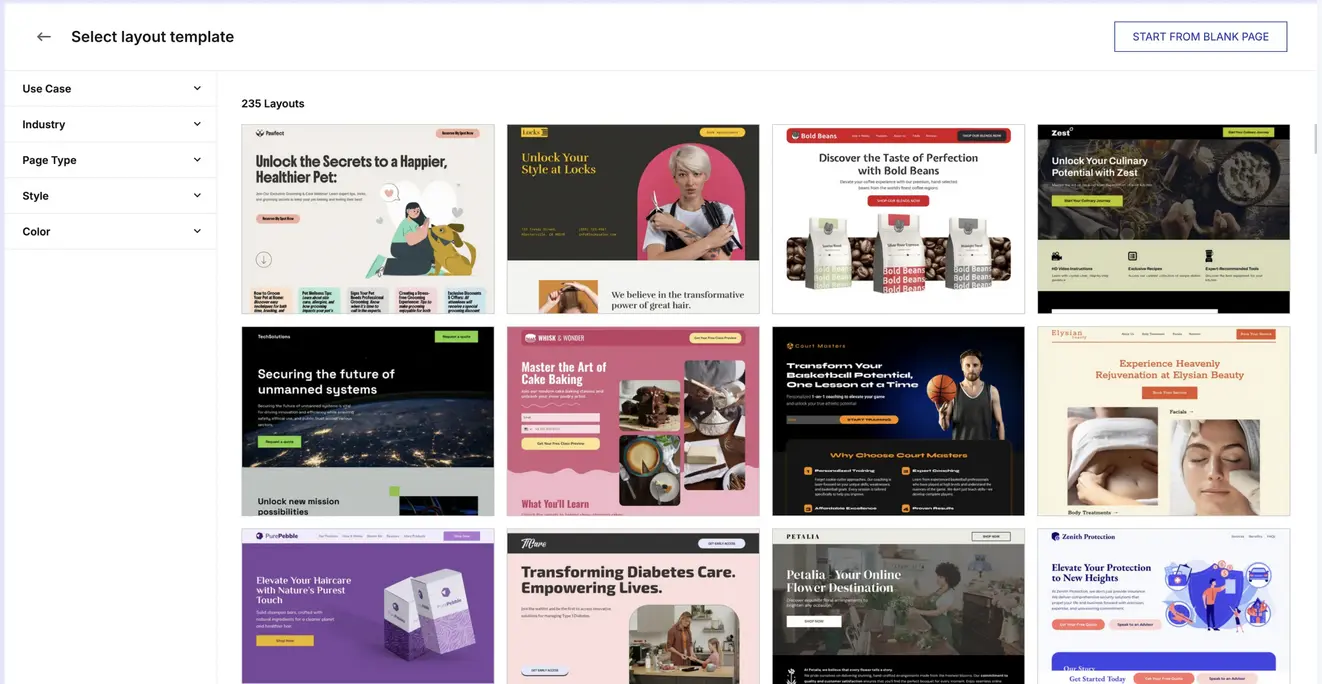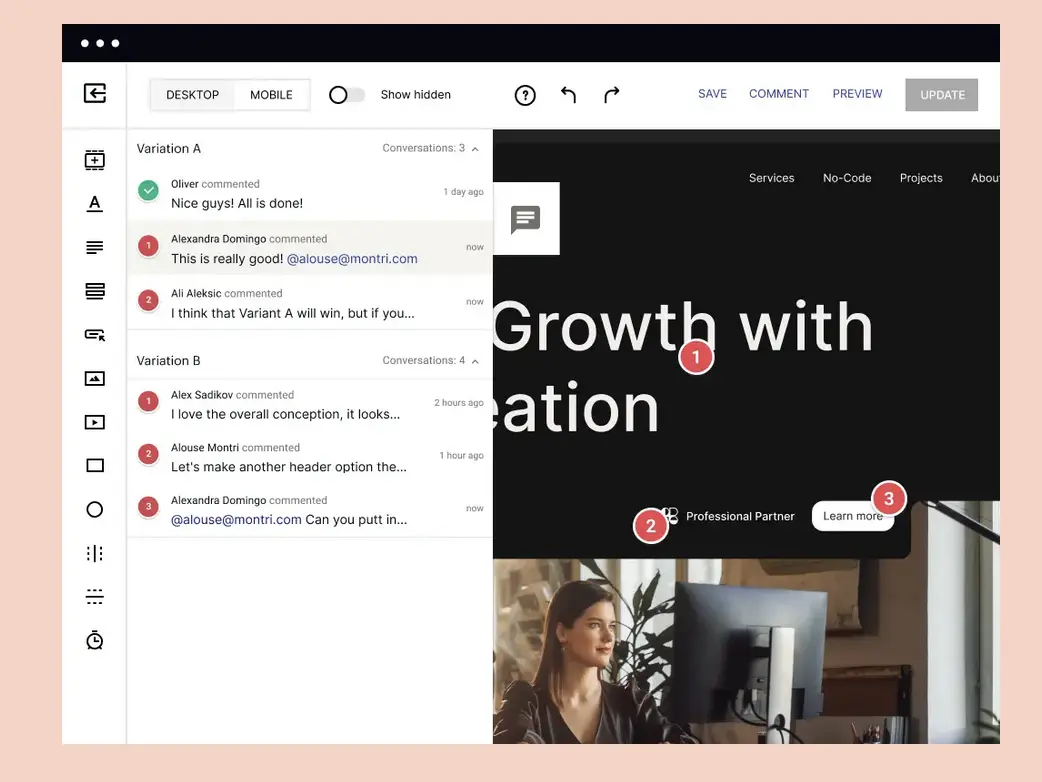Once your website is live, your goals shift from building pages to driving performance. You need a platform that not only gets your pages online fast, but also helps you test what works and scale results across every campaign.
Squarespace makes it easy to create a polished website and get online. Instapage goes further—offering the same intuitive, drag-and-drop experience while adding the power to create, test, and scale both websites and landing pages from a single platform.
From your homepage to your highest-converting campaign pages, Instapage connects every experience to your marketing stack, enables real-time collaboration, and provides the insights you need to optimize for conversions—not just clicks.
In this guide, we’ll compare Instapage vs. Squarespace to help you choose the platform that aligns with your goals—and grows with your marketing, not past it.
Instapage vs. Squarespace at a glance: features, focus & workflow
| Instapage | Squarespace |
| Instapage includes built-in A/B testing, heatmaps, personalization, and conversion analytics. | Squarespace generally requires third-party tools or custom code for advanced testing and behavioral insights. |
| Instapage’s interface is built for marketers launching high-performing campaigns with websites and landing pages. | Squarespace focuses on website creation and brand presentation, with landing pages as a secondary use case. |
| Instapage offers team collaboration with granular permissions, version history, and real-time commenting—ideal for marketing teams. | Squarespace provides basic multi-user access designed primarily for website management. |
| Instapage lets you create reusable components across your campaigns. With Global Elements, you can build headers, pricing sections, or CTAs once, deploy them across pages, and update them everywhere with one click—streamlining campaign management. | Squarespace allows global content and code blocks on its Enterprise tier via the Design Library, but standard plans require manual updates per page. |
| Instapage integrates directly with ad networks, CRMs, and email tools—allowing marketers to capture leads, send follow-ups, and measure performance from a single workspace. | Squarespace supports native email campaigns but relies on external tools for advanced automation and lead management. |
| Instapage is built for marketers who need to create, test, and scale conversion-focused pages and sites. | Squarespace shines as an intuitive, design-led website builder—best for small businesses and creators who prioritize simplicity over advanced campaign workflows. |
Squarespace: simplicity at launch
Squarespace prioritizes simplicity and consistency. It’s designed for quick setup and cohesive brand visuals. The section-based editor uses predefined layouts and templates, making it ideal for creators, small businesses, and anyone looking to build a polished website with minimal customization overhead.

Instapage: flexibility for optimization
Instapage, on the other hand, offers pixel-level design control, while still maintaining ease of use. You get the drag-and-drop editor, but with the freedom to rearrange, reuse, and iterate layouts.

For example:
- You can create a hero section with a background video, adjust alignment and grouping, and apply those changes to mobile instantly, thanks to features like mobile grouping and alignment.

- You can save reusable sections (Instablocks/Global Elements) and apply them across campaigns, so design updates propagate quickly.

If your goal is to publish once, Squarespace makes it simple. If your goal is to test, iterate, and relaunch often, Instapage makes that effortless.
Collaboration & campaign management
Squarespace: content-centric
Squarespace supports multiple contributors, but its collaboration features are built for content management, not campaign execution.
You can assign roles like Administrator or Editor, but there is no built-in version history, comment threads on pages, or advanced approval workflows. Moreover, updates across multiple campaign-specific pages typically require manual updates or duplication of effort.
Instapage: built for marketing teams
Instapage was designed with marketing and growth teams in mind. Real-time collaboration enables designers, writers, and stakeholders to work in a single workspace, complete with visual comments and tags. Granular permissions ensure each user sees only what they should.

Plus, with Global Elements, you can roll out site-wide updates (e.g., change a CTA style or compliance footer) across dozens or hundreds of campaign pages with one click.
This means faster production cycles, fewer errors, and more consistent branding—especially important when your team launches multiple campaigns in parallel.
Testing, analytics & performance
Here’s where the two platforms differ most in marketer workflows.
Squarespace: basic analytics, external tools required
Squarespace provides built-in analytics focused on site traffic: page views, visitor sources, and broad engagement metrics. But when you want to compare variations, see heatmaps, or tie behavior to conversion metrics, you’ll need to implement custom tracking or integrate external tools.
For example, to run A/B tests, you might need Google Optimize or the addition of custom code blocks.
Instapage: experiments + insights in the same platform
Instapage integrates testing, behavioral analysis, and optimization tools directly into the workflow.
With A/B testing built in, you can duplicate a page, change a headline, adjust a layout, and compare performance side-by-side, all without external plugins. Heatmaps show where visitors click, scroll, or drop off. Conversion analytics tie your traffic to outcomes. And you can use personalization to show different versions to segments based on source or audience attributes.
For example, marketers using Instapage can easily duplicate a page, shorten or expand a form, and see which version converts better—all tracked automatically within the same workspace. Squarespace users can run similar tests, but the process typically requires third-party tools or manual setup to collect and compare results.
Integrations & automation
Squarespace: primarily website and eCommerce integrations
Squarespace offers integrations geared toward website management, content publishing, and eCommerce, including payments, bookings, marketing email campaigns, domain & hosting, extensions, and more.
It’s strong for unified site experiences but less focused on handing off leads into a marketing tech stack or automation funnel.
Instapage: built for marketing stack connectivity
Instapage is designed to connect seamlessly with the tools modern marketing teams rely on, including CRMs, ESPs, analytics platforms, and ad networks. You can capture a lead on any page and automatically route it to the right system for follow-up.
With features like Direct Lead Integrations, Custom Webhooks, and Native Marketing Integrations, Instapage ensures your campaigns stay connected end-to-end, without manual exports or middleware.

When you’re running multiple campaigns, testing creatives, and tracking conversions across channels, this level of connectivity turns your website and landing pages into a fully integrated part of your marketing engine, not a silo.
Pricing & scalability
Squarespace: affordable for websites
Squarespace offers affordable, subscription-based plans for website management, making it an attractive choice for creators and small teams. But the model is oriented around site features (templates, hosting, eCommerce) rather than campaign scale.
If you launch multiple landing pages, generate large volumes of traffic, or require tight performance optimization, you may encounter friction or need workarounds.
Instapage: premium built for growth
Instapage is built to grow with your marketing needs. From Global Elements to experimentation tools, the real value appears when you launch high-volume campaign workflows. You can create, optimize, and scale without rebuilding or duplicating effort.
Over time, the efficiency gains from faster launches, fewer technical dependencies, and better conversion optimization can justify the investment.
When to use each platform
Use Squarespace if you:
- Need a beautiful website with minimal setup.
- Don’t rely on high-volume paid traffic or sophisticated testing.
- Are a creator, small business owner, or solo entrepreneur focused on site presence rather than campaign performance.
Use Instapage if you:
- Run ad campaigns or paid traffic initiatives that focus on conversions.
- Need testing, personalization, and built-in analytics.
- Work in a team launching multiple campaigns and pages simultaneously.
- Want to launch, optimize, and scale all from one unified platform.
Choose the platform built for performance, not just an online presence
Both Instapage and Squarespace make it easy to build and publish a beautiful site. But where Squarespace focuses on helping you get online, Instapage is built to help you grow — giving marketers the tools to test, optimize, and scale every campaign from one place.
From your homepage to your highest-converting landing pages, Instapage unifies your workflow—connecting design, analytics, collaboration, and automation in a single platform. You can launch new pages quickly, personalize experiences for every audience, and continuously improve performance without relying on developers or multiple disconnected tools.
If you’re ready to go beyond website building and start creating marketing experiences that convert, Instapage gives you everything you need to do it—faster and smarter.
Ready to see what a complete landing page and CRO solution can do for your growth?
Start your 14-day free trial today and experience the difference Instapage makes for your workflows.
